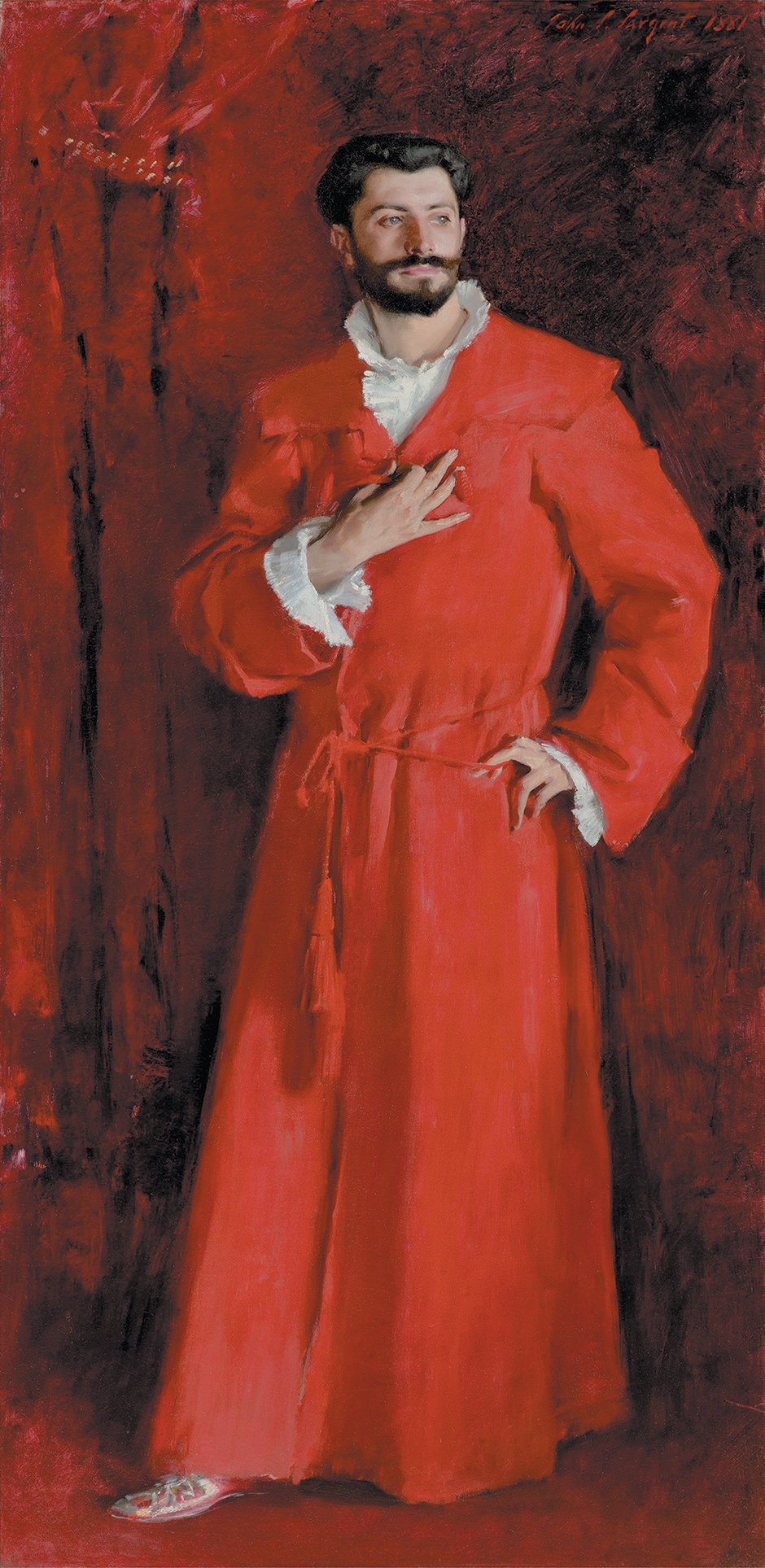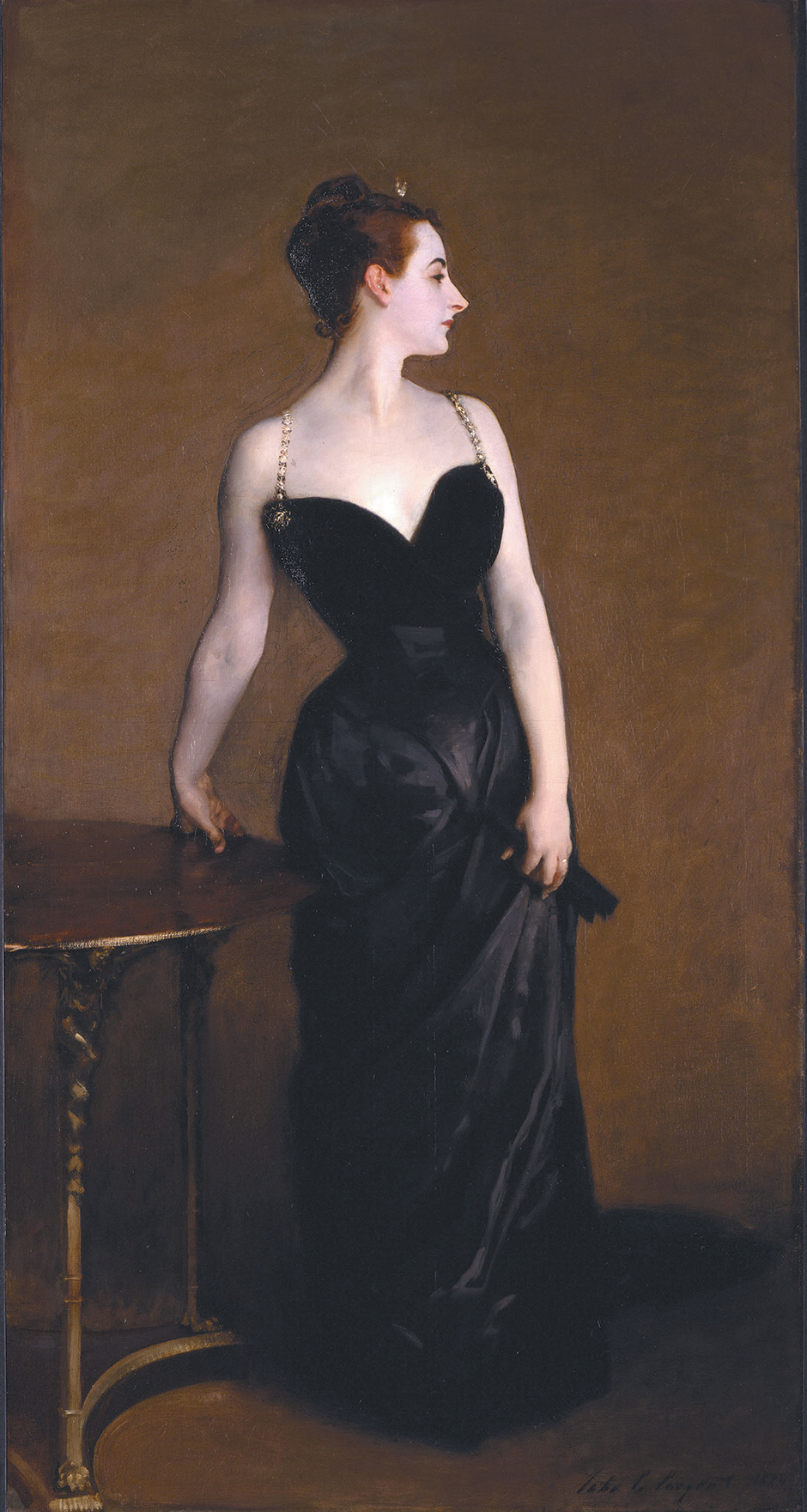At the age of fifty-one, with his work in high demand on both sides of the Atlantic, John Singer Sargent swore off painting portraits. He had been eager for some time to escape the confines of the studio, the pressures of multiple sittings, and society portraiture altogether. “No more paughtraits,” he wrote to a friend in 1907. “I abhor and abjure them and hope never to do another especially of the Upper Classes.” He had been charging a thousand guineas a portrait “in order to have fewer to do,” he told another friend, but price did not discourage his affluent clientele.1 A Max Beerbohm cartoon shows the portly, bearded artist peering out the window of his London studio in alarm at a queue of fashionably dressed ladies, with uniformed bellhops holding places in line for more.
Sargent made exceptions to the portrait ban for friends, and for eminences such as Lord Curzon, the archbishop of Canterbury, John D. Rockefeller, and Woodrow Wilson (he turned down Pierpont Morgan). Yet for the most part, once he had slipped the silken shackles of commissions, he turned his attention to painting murals for the Boston Public Library, and to doing more of what he had loved all his life: traveling, often with artist friends, and working outdoors in natural light.
The “off-duty” paintings he did primarily for his own pleasure tend, not surprisingly, to be looser, more intimate and experimental than his formal grand-manner portraits, and about ninety of them are currently on view at New York’s Metropolitan Museum of Art in an exhibition called “Sargent: Portraits of Artists and Friends.” Organized by the National Portrait Gallery in London, where it opened last spring, and curated by Richard Ormond with Elaine Kilmurray, the coauthors of the definitive Sargent catalogue raisonné (eight volumes so far), it brings together from public and private collections a glorious selection of some of the artist’s finest work. For New York, the Met’s Elizabeth Kornhauser and Stephanie L. Herdrich have added works from the museum’s own extensive Sargent collections, including twenty-one on paper.
Sargent seems to have known everyone, and his cultural tastes ranged from Wagner and Voltaire to Javanese dancers and Charlie Chaplin. Very much in evidence here are the vitality and technical virtuosity of his work, his insistence, as Richard Ormond describes it, “on the material of paint, on the flux and instability of surface textures, on condensed forms and odd angles of perspective.” The exhibition traces the arc of Sargent’s career over geography and time. Among its abundant pleasures is a quiet sense that the paintings trace the reticent artist’s own profile through his life in art, which is where he most intensely lived.
Sargent, said one of his biographers, was “at home everywhere, and belonged nowhere.” Born in Florence to American parents in 1856, he grew up in Europe yet always considered himself American. His father, FitzWilliam Sargent, a Philadelphia physician from an old New England family that had made and lost a fortune in shipping, and his mother, the former Mary Newbold Singer, crossed the Atlantic with Mary’s mother in 1854 after the death of a two-year-old daughter, hoping to calm Mary’s “nerves,” and stayed abroad for the rest of their lives. They were living in a rented house near the Ponte Vecchio in January 1856 when their son was born. His grandmother called him “fra Giovanni.”
The family, including two daughters by 1870, lived on Mrs. Sargent’s small inheritance and moved with the seasons—Rome, Naples, Capri, the Tyrol, Dresden, Carlsbad, Venice. John sketched and painted wherever they went. He learned French, Italian, some German and Spanish, and could have had a career as a pianist. In 1870 he won the annual prize in drawing at the Accademia delle Belle Arti in Florence. Paris, to which the family moved in 1874 so that he could study art, was his first settled home.
He enrolled in the École des Beaux-Arts and joined the atelier of the society portrait painter Charles-Émile-Auguste Durand, known as Carolus-Duran. Carolus forbade his students to make academic preparatory drawings on paper; instead, he taught them to load up brushes with paint and work directly on canvas in layers of wet oils, a process that requires spontaneity and speed. His paramount advice was: “Velasquez, Velasquez, Velasquez, étudiez sans relache Velasquez.”
Sargent studied Velázquez in Spain and Franz Hals in the Netherlands, frequented Paris galleries and exhibitions, and revered Édouard Manet. He visited America for the first time at the age of twenty in 1876. His European worldliness may have shocked some of his new Boston admirers. From Capri in August 1878 he wrote to a childhood friend:
If it were not for one German staying at the Marina, I should be absolutely without society and he is in love and cannot talk about anything but his sweetheart’s moral irreproachability. We are going over to Sorrento in a day or two to visit her, and I have agreed to keep her husband’s interest riveted to Vesuvius, Baiae, Pozzuoli and other places along the distant opposite shore.
His first major portrait, exhibited at the Paris Salon of 1879, was of Carolus himself, inscribed (in French) “to my dear master M. Carolus Duran, his affectionate pupil/John S. Sargent. 1879.” It was an astonishing debut. Sargent posed the charismatic dandy at an asymmetrical tilt, leaning to his right and slightly forward as if about to get up and speak. White frilled shirt cuffs blaze against a fawn-colored jacket. A viewer’s eye is drawn to the painter’s articulate hands, the left bent askew against a thigh, the right, deftly foreshortened, almost caressing a carved wooden cane. Sargent gives the figure volume and weight with tonal shades—his strongest portraits capture exactly this sense of powerful physical presence. Edmond de Goncourt reported Degas asking “with spirit,…‘have you seen Carolus’s cuffs and the veins in his hands, filled by the beat of a Venetian pulse?’”
Advertisement
Carolus introduced Sargent to the subject of another highly theatrical portrait, this one commissioned: Dr. Pozzi at Home (1881). The father of modern French gynecology, Samuel-Jean Pozzi made revolutionary advances for women’s reproductive health and served as surgeon to the stars of the Parisian beau monde. An outrageously attractive aesthete and sensualist, he belonged to the circle around Proust and Robert de Montesquiou, had many lovers (including Sarah Bernhardt), collected art, and invited audiences to watch his surgical procedures.
Sargent portrays him looking like a sexy cardinal or pope in a full-length scarlet dressing gown, in a room of deeper red, evoking earlier portraits by Velázquez and Van Dyck. “The symphony of reds,” notes Elaine Kilmurray in the exhibition’s excellent catalog,
is insistent and visceral (a gesture to the sensational aspects of his medical practices), but the flashiness is offset by the refinement of his finely drawn surgeon’s hands, exquisitely pleated white shirt and delicately embroidered slippers.
The elegant long fingers may also allude to Pozzi’s skills as a lover. Dr. Pozzi was the first Sargent painting exhibited at London’s Royal Academy, in 1882.2
The scandal over Sargent’s Madame X radically changed the artist’s life. Fascinated by the cold beauty and dramatic self-presentation of Virginie Gautreau, the Louisiana-born wife of a French banker, he painted her portrait without commission, hoping it would gain him recognition. It did, but not the kind he wanted. Exhibited at the Salon of 1884, the painting shocked Paris. The ensuing scandal surprised both artist and subject. A prominent social figure, Madame Gautreau was something of an empty celebrity, known for being known. With her strange makeup (her powdered skin looks deathly lavender-green), haughty pose (Sargent accentuates her avian profile, and the awkward torque of her right arm gives a nervous tension to her whole body), and brimming décolletage (the strap of her dress was slipping off her right shoulder in the original portrait—Sargent later repainted it), she appears, and probably was, morally lax. That both model and artist were American may have added to the fire. Having agreed to pose for the portrait, Madame Gautreau disavowed it and went into seclusion for months. Sargent kept it in his studio until 1916, when he sold it to the Metropolitan Museum, saying, “I suppose it is the best thing I have done.”3
As demand for his portraits plummeted in the aftermath of the scandal, Sargent thought he might have to give up art altogether and go into music or business. He was just twenty-eight. His fellow Euro-Americans James McNeill Whistler and Henry James had for some time been urging him to move to England, and by 1885 the prospect seemed attractive. Sargent spent that summer and the next with a group of American painters and writers at a village called Broadway in the Cotswolds, working outdoors on a series of Impressionistic projects under the powerful influence of Claude Monet.
He had met Monet in the 1870s, and they became good friends in the 1880s. On a visit to Giverny, Sargent painted the sketch Claude Monet, Painting, by the Edge of a Wood, probably in July 1885, and kept it for the rest of his life. His vantage point behind the artist doing what he himself is doing—painting en plein air—reveals the landscape study Monet is working on, which appears to be Près à Giverny (Meadow with Haystacks Near Giverny). Sargent began acquiring Monet landscape paintings in 1887—ultimately he owned four. When an American collector in 1889 threatened to buy and deport the object of an earlier French art-world scandal, Manet’s Olympia, Sargent and Monet waged a successful campaign to purchase the painting for the Louvre.4
Advertisement
The friendship between the two artists lasted into the 1900s. In February 1901 they watched Queen Victoria’s funeral procession together from a house opposite Buckingham Palace, and in March Sargent helped secure a space from which Monet could paint Leicester Square at night. Ultimately, however, he turned away from Impressionism’s optical mixes of pure color and its emphasis on texture and pattern over form and structure to work in the Velázquez/Carolus vein, with ensembles of tone. In an apt but most likely apocryphal story, he is said to have one day asked Monet to lend him a tube of black paint, and been astounded to learn that his companion had none.
Henry James proved enormously instrumental in helping Sargent find congenial new artistic and social worlds in England, as well as patrons on both sides of the Atlantic. In October 1887 he published a lavish appreciation of his compatriot’s work in Harper’s New Monthly Magazine. Sargent’s early portraits, James wrote, offered the “slightly ‘uncanny’ spectacle of a talent which on the very threshold of its career has nothing more to learn.” He went on to describe many of the paintings in vivid detail (a Venetian interior is “bathed in a kind of transparent shade”), and concluded: “There is no greater work of art than a great portrait—a truth to be constantly taken to heart by a painter holding in his hands the weapon that Mr. Sargent wields.”
Americans were quicker to take up Sargent than Europeans. James introduced the artist to Isabella Stewart Gardner, the wealthy Boston collector who became one of his good friends and most steadfast patrons. She hung his great flamenco picture, El Jaleo, and many more of his paintings and watercolors alongside old master works in her Venetian-style palazzo on the Fenway. She commissioned Sargent to paint her portrait in 1887. He posed her against a wall of dramatic Venetian brocade, in an odd yet powerful painting: the circular pattern in the brocade gives her a halo; pearls encircle her neck and waist, and her arms, shoulders, and clasped hands form yet another loop. Mrs. Gardner was no beauty—Sargent said her face looked like “a lemon with a slit for a mouth”—but he captured her character and tense energy. Her husband, along with several art critics at the portrait’s first public showing, hated it. Mrs. Gardner kept it in a private room at Fenway Court during her lifetime—and it has only now left Boston for the first time to come to the Met.
Sargent and James already had a number of friends in common. After visiting the consumptive Robert Louis Stevenson and his wife at Bournemouth, a health resort on the south coast of England, in June 1885, Sargent reported to James: “I was very much impressed by him; he seemed to have the most intense nature I had ever met.”
His two surviving paintings of Stevenson render that essential intensity precisely. In one, the writer looks like a giant vertical spider, pacing and talking, tweaking his mustache, separated by a mysterious open doorway from his wife, who reclines on a sofa dressed as an Indian princess and practically falls off the edge of the canvas. That Sargent did not flatter his sitters had been clear for some time, and like many of those not flattered, the Stevensons loved this painting. Fanny Stevenson told her mother-in-law: “Anybody may have a ‘portrait of a gentleman’ but nobody ever had one like this. It is like an open box of jewels.”
Sargent was as generous a friend to other artists (among them Paul César Helleu, Albert de Belleroche, and Antonio Mancini) as Henry James was to him, introducing them to patrons, promoting their work, lending or giving them money. One spring he told his friend Asher Wertheimer that the young French pianist and composer Léon Delafosse, in London to give two concerts, would commit suicide on the upcoming Whitsunday unless he could spend it in the country—would Wertheimer invite the man to his country house for the day?
In 1887 Sargent took a three-year lease on a studio on Tite Street in Chelsea that Whistler had recently occupied, though as always he traveled for long stretches of the year—to America, Italy, Spain, North Africa, the Levant. Impermanence seemed to be his permanent condition—as late as 1894 he said he was still only “vaguely” living in London. He eventually bought the studio at 31 Tite Street—across the street from Oscar Wilde and not far from Henry James—and a few years later combined it with 33 next door. He lived there for the rest of his life. Two superb portraits of British women, Mrs. Hugh Hammersley and Lady Agnew of Lochnaw—painted in 1892 and exhibited to wide critical acclaim the following year—opened the floodgates for society commissions. By the time Sargent was elected a full member of the Royal Academy in 1897, he was the leading Anglo-American portrait artist of his generation.
Ten years later he gave up painting “paughtraits.” The art historian Trevor Fairbrother writes in the exhibition catalog about the two kinds of work Sargent turned to after renouncing portraiture—painting watercolors and oils inspired by his travels, and creating mural decorations for cultural institutions in Boston. According to Fairbrother, Sargent “knew that these radiant [travel] pictures sustained his reputation as an exponent of Impressionist experiment, and mainstream critics gladly talked up their vitality and brilliance.” The large themes addressed by the murals—religious history, the Great War, classical mythology—“reflected an ambitious need to offset his costly, fashion-tinged portraits with an erudite legacy.”
Are these works in the end better or more important than the portraits? Crowds do not line up to see the murals the way they do for an exhibition of Sargent’s people. Is this an instance, not uncommon, of an artist giving up what he does best in order to do something more serious, weighty, lasting? Perhaps. Yet to the extent that Sargent was concerned about his artistic legacy, “Portraits of Artists and Friends” makes clear that he need not have been.
This Issue
October 8, 2015
The Pope & the Market
Ukraine & Europe: What Should Be Done?
-
1
A guinea is a little more than a pound sterling. In the early 1900s a thousand guineas was worth about $5,000—equivalent to roughly $75,000–100,000 today. ↩
-
2
In June 1885 Sargent wrote to Henry James introducing “Dr. S. Pozzi, the man in the red gown (not always), a very brilliant creature! &…the unique extra-human Montesquiou…. They are going to spend a week in London and I fancy Montesquiou will be anxious to see as much of Rossetti’s and Burne Jones’ work as he can. I have given him a card to BJ.” ↩
-
3
The portrait was originally titled, less sensationally, Madame***, as if to protect the identity of the sitter, although no one in Paris society would have failed to recognize Madame Gautreau. In 1916 Sargent asked the Met to disguise her name again, and the painting has since been known as Madame X. ↩
-
4
Manet died in 1883, a year before the Madame X scandal, and there is no evidence that he and Sargent met. The two paintings that received the most publicity at the Salon of 1882 were Manet’s A Bar at the Folies-Bergère and Sargent’s El Jaleo. At the Manet sale of February 1884, Sargent bought The Portrait of Mademoiselle Claus—a preparatory study for Le Balcon—and Irises. He was one of the few foreign artists to attend a memorial banquet for Manet in January 1885. ↩





